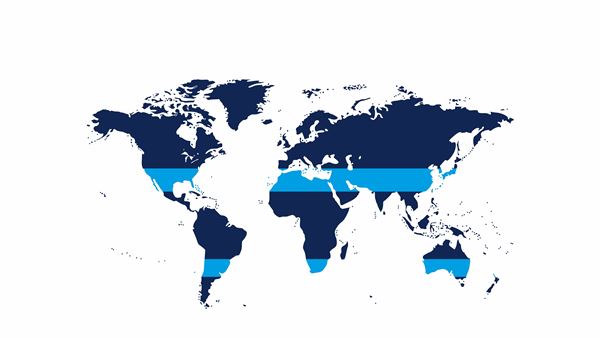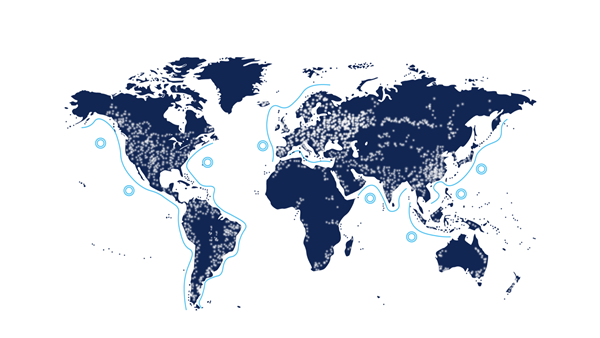Our Floating Solar Technologies
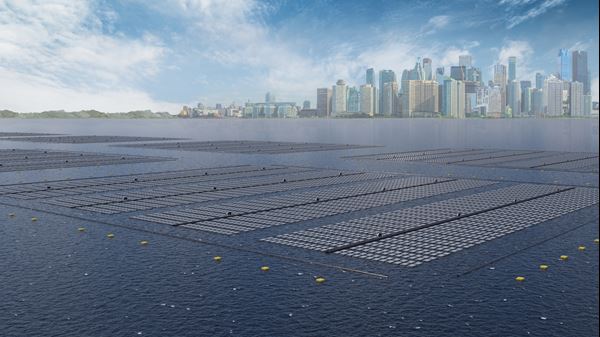
The Floating PV Technology, BRIZO
BRIZO is a pioneering Floating Photovoltaic (FPV) technology created to unlock the potential of floating solar. BRIZO’s elegant simplicity enables a new standard of cost-efficiency as it leverages readily available components in the existing global supply chain and uses well-established fabrication methods. Its use of recycled materials and easily recyclable components further enhances its environmental profile. BRIZO stands out for its easy assembly in areas with limited infrastructure, eliminating the need for heavy equipment and overcoming space limitations.
Discover the future of solar energy with our current floating solar solution, BRIZO, built on the experience and heritage of the Fred. Olsen-related companies.
Why floating solar?
Floating Solar or Floating PV has great potential to be an important part of the energy mix of the green transition.
In the transition from a fossil-fuel-based society to a zero-emission society, there is a tremendous need for new renewable energy solutions, with solar energy emerging as one of the cheapest and most accessible technologies.
Recognizing the scarcity of land, especially in areas close to cities where most people reside, the concept of floating solar farms at sea; rivers, lakes, and near-and offshore environments becomes compelling. By harnessing solar power offshore, we can generate significant renewable energy close to populated areas. This innovative approach not only maximizes efficiency but also avoids occupying valuable land that could be utilized for essential purposes such as food production and recreation.
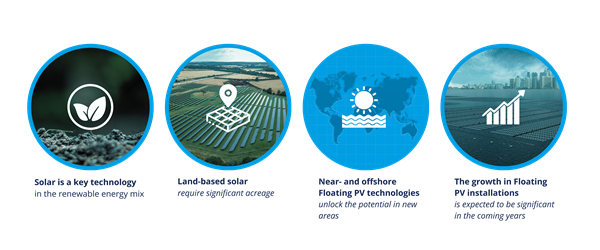
The Current and Future Market for Floating Solar PV Solutions
The global floating solar market has witnessed significant growth, driven by the increasing demand for renewable energy and the challenges posed by land scarcity.
With 71 percent of the Earth's surface covered by various water bodies such as rivers, lakes, and near-and offshore environments, floating solar solutions have emerged as a viable and sustainable option to harness solar power.
Deploying floating solar solutions requires careful consideration of the unique characteristics of each location. A suitable technology in one area may not be appropriate in another. Therefore, there is a demand for diverse floating PV technologies tailored to specific water environments.
Floating solar developers draw significant attention to locations exhibiting high production potential and facing land scarcity challenges.
Floating PV Benefits
Floating PV presents various benefits, displayed in various forms. The primary importance lies in its environmental efficiency and friendliness, serving as a highly effective means of energy generation.
The reason why near- and offshore floating PV solutions have significantly enhanced energy production is, that PV technologies benefit from the cooling effect induced by water. This means that floating PV not only unlocks the potential to repurpose existing water bodies for renewable energy but also demonstrates heightened efficiency.
Floating solar holds immense promise for the future of renewable energy, offering not only increased resilience to high wind and wave loads but also delivering significant environmental benefits. However, achieving the optimal balance of proximity to water for efficient cooling while mitigating the impact of powerful waves poses a challenge in deploying floating solar technologies.
What are the disadvantages of floating solar?
Floating PV is broadly considered a commercially viable solution; however, deployment challenges remain a concern. Floating PV has yet to demonstrate consistent performance over an extended period while navigating ocean environments and presenting a host of challenges including uncertainties surrounding cost.
A Floating PV design therefore needs to be built to withstand water environments, while addressing anchoring issues, but at the same time be designed with simplistic elements making it cost-effective. Another important layer of complexity to designing floating PV technologies is managing operations and maintenance.
Therefore, there is a need for a floating PV technology that is tailored to withstand wind and wave loads and designed simplistically, making it easy to implement, operate, and maintain.
Overcoming the disadvantages of floating solar:
Elegant simplicity:
BRIZO’s elegant simplicity enables a new standard of cost-efficiency since the solution is comprised of just five essential components: Floating modules, Panels, Rope Locks, Rope, and Pe-pipes, which streamlines the complexities associated with floating solar manufacturing.
By leveraging readily available components in the existing global supply chain. This allows for flexibility and local content optimization, making BRIZO a cost-effective solution.
BRIZO’s design uses well-established fabrication methods, including injection- and blow molding. This allows the floating modules to be mass-produced at a low cost.
BRIZO utilizes recycled materials, and all components can be readily recycled at the end of their life cycle. The floating solar solution offers a distinct advantage as it allows for assembly in areas with limited infrastructure.
Withstanding wind and wave loads:
The Floating PV Technology, BRIZO, is tailored to withstand wind and wave loads, utilizing a few yet crucial components enabling it to thrive in dynamic ocean environments.
The rope mesh is pre-tensioned to provide stability and to avoid compression and collision of the floating elements in the system. Each floater is individually anchored to the rope mesh. This means that forces will not be transferred from floater to floater.
In strong winds, localized anchoring ensures the floaters are pushed down towards the sea surface keeping the system stable.
The PE pipes are the interface between the mooring system and the rope mesh. They provide the necessary buoyancy, stiffness, and flexibility to the system, and act as a protective barrier against short and steep waves. The bridle lines’ primary role is to distribute the forces effectively and evenly from the mooring lines to the PE pipes. This provides a continuity from the bridle lines to the rope mesh.
BRIZO can employ various anchoring solutions depending on site-specific environmental loads and seabed conditions
Read more about the Floating PV Technology, BRIZO, here:
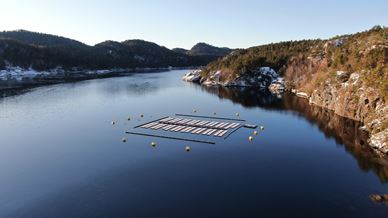
NEWS UPDATE: Fred. Olsen 1848 has deployed the Floating PV Technology BRIZO in Risør, Norway
Fred. Olsen 1848 is proud to announce that the 50x50 meter, 124 kW pilot project in Risør, Norway has successfully been deployed… Read more

Fred. Olsen 1848 welcomes Per Arvid Holth as its new CEO. He succeeds Sofie Olsen Jebsen and will take up the position on 1 March 2024.
Fred. Olsen 1848 welcomes Per Arvid Holth as its new CEO. Per has since 2022 held the position as Chief Project Officer in Fred.… Read more
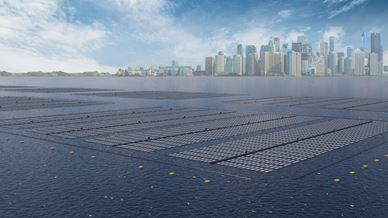
INTRODUCING BOLETTE – THE TECHNOLOGY TO UNLOCK THE POTENTIAL OF NEAR- AND OFFSHORE FLOATING SOLAR
The main challenge for floating solar, particularly in marine environments, is how to handle wave loads in combination with wind… Read more

